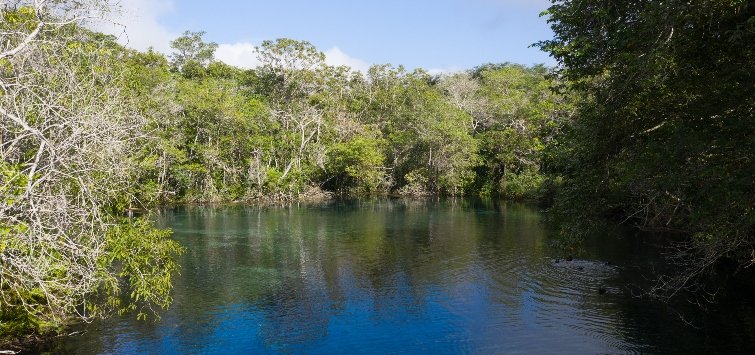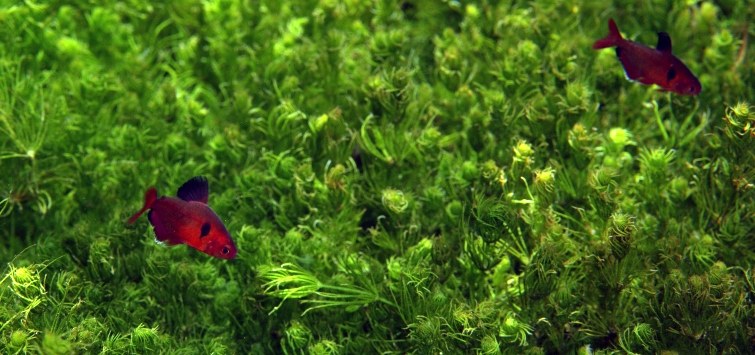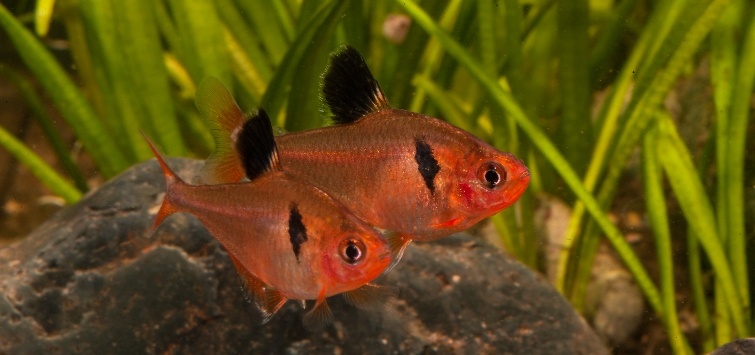Swimming with Serpae Tetras in Brazil
The serpae tetra is one of the world’s oldest and most popular aquarium fishes. They are easy to breed and are widely available in albino and long-fin forms, sure indicators (bittersweet to those of us who are familiar with the wild form) that they have been in the hobby long enough to have been largely bred out of their natural shape and beauty over their decades of captive breeding.
To really understand and appreciate this bright red gem of a fish—whose alternate common name of jewel tetra perhaps does it more justice—you really have to see how schools of them swim among the tangles of roots and plants of their native waters, which range across several South American river basins.
The correct scientific name for the serpae tetra is Hyphessobrycon eques, described by Steindachner back in 1882. Some older books have them variously named H. serpae and H. callistus, but these are both synonyms of H. eques. It is not surprising that this fish would have been described multiple times, as its native range is widespread across a wide region of Brazil, Bolivia, Paraguay, and Argentina, throughout the Guapore and Paraguay river basins.
Snorkeling with Serpaes in the Pantanal Wetlands

The largest groups of serpaes I have ever observed were found when I was snorkeling in the black waters of the Rio Salobra, one of the larger rivers of the Brazilian Pantanal wetlands. Here, in tea-stained water of around 70°F (21°C), thousands of serpae tetras share the shallows with other well-known aquarium fishes, including fire tetras (Aphyocharax rathbuni), red-eyed tetras (Moenkhausia sanctaefilomenae), phantom tetras (H. megalopterus), pygmy catfish (Corydoras hastatus), and several species of Apistogramma dwarf cichlids.
All these small fishes occur in mixed schools, tightly clustered together in the shallow water, where a tangle of tree roots and dense aquatic plant growth offer some shelter against various predators. This dense and chaotic crowd of fish is constantly in motion, always near the bottom substrate.
In the headwaters of the Pantanal, small rivers like the Rio da Prata drain the Serra da Bodoquena mountains into the immense wetland below. The water here is even cooler, reaching only around 65°F (18°C) as it emerges from the ground. The serpae tetra is also abundant here, living among a very different community of fishes that are better adapted to the cool alkaline water emerging from limestone-rock springs that feed the rivers.
Here H. eques is one of the few smaller fishes, spending most of the day hidden under dense stands of swordplants (Echinodorus spp.) and emerging only in the shallows or in very large schools where the complex bottom structure can provide shelter against predators.
Various different tetras share the habitat with the serpaes in the Rio da Prata, with Moenkhausia bonita and Astyanax marionae being the common species. Large Leporinus and Prochilodus spend their day disturbing the substrate, and the mixed schools of tetras often follow behind to snatch up small particles kicked up by the larger fish.
In general, the serpae tetra is found in cooler waters such as these, south of the Amazon basin and even down into Argentina, where they can be seen in Esteros del Ibera, in water temperatures of just 50°F (10°C).
At higher temperatures, H. eques not only loses the brilliant red coloration, but is also considerably more aggressive. This simple fact is often overlooked when this tetra is sold as a community fish for tropical tanks. Housed in warmer water with common serpae tetra tankmates like angelfish, guppies, gouramis and other slow-moving, long-finned fish they can be problematic, nipping at the fins.
This tetra is a perfect community fish, though, if housed in the right company: other cool-water-tolerant species that are equally active, and who don’t get too stressed if their fins are occasionally nipped. However, because of the huge range of the serpae, establishing a list of species that would make an appropriate biotope with them is not a cut-and-dried task.
Tetra Predators of the Rio Salobra

Predators are abundant where I swam with the serpaes in Brazil’s Rio Salobra, but the large predatory cichlids here, such as the pike cichlids Crenicichla vittata and C. reticulata, as well as the lesser-known oscar species Astronotus crassipinis, rarely enter the shallows, instead preferring to snatch the tetras that stray too far off the bank into deeper water chasing floating food items.
The piranhas in the river also seem to focus on prey and carrion in deeper water, with the exception of Catoprion mento, the scale-eating wimple piranha. The juveniles of that species readily mix into the mixed schools of tetras to feed on the scales of the unsuspecting little fish.
The greater threat in the shallows where H. eques dwell comes from two of the larger predators, these being the wolf fish and dorado, each with completely different strategies. Wolf fish (Hoplias malabaricus) of all sizes, up to 18 inches (45 cm), spend their days lying in shallow water that often just barely covers their back. They ambush the small tetras swimming past them, as well as any unfortunate individuals that mistake a wolf fish for a sunken log and attempt to use it as cover.
The dorado (Salminus brasiliensis) has an entirely different approach: This large predator will swim into the shallows at great speed from the open water, snatching at any small fish separated from the school. They will attack the mixed school of smaller species in this way at regular intervals throughout the day. Later, with the onset of darkness, stingrays and catfish also enter the shallows to feed on the tetras as they sleep.
Lessons from Swimming with Serpaes

But perhaps the most surprising feature of the wild serpaes I’ve observed is their intense red coloration. This most spectacular fish has lost so much of its color over generations of inbreeding in captivity, and the warmer water in which they are typically kept in aquaria seems to further wash them out.
Considering the conditions in which I’ve observed H. eques living in their natural habitat, a totally different approach for keeping this species may be warranted, especially in the area of water temperature. I believe we should be keeping this species at cooler temperatures than found in the typical community aquarium. In eastern Canada, I’ve kept these tetras outside in unfiltered large containers, in the shade, and they’ve thrived from mid-May until mid-September.
This also means, of course, that serpae tetra tankmates tankmates should also be tolerant of cooler water, equally active species that also like to nip fins on occasion and can hold their own with the serpaes, such as Aphyocharax, Pyrrhulina, Hemigrammus ulreyi, and Astyanax spp. tetras.
Also consider keeping them with a higher water flow, and be sure to buy the original form with short fins rather than line-bred variants like longfins. If you can get specimens that are as close to the wild form as possible, and keep them in the right conditions, you will see how beautiful this species really can be.
Check out the author’s video of H. eques in their natural habitat.
See the full article on TFH Digital
https://www.tfhdigital.com/tfh/jan_feb_2021/MobilePagedReplica.action?pm=2&folio=60#pg63

.png?h=595&iar=0&w=2781&hash=5FD5E69473BCC22199FBFA2FB71B6033)



